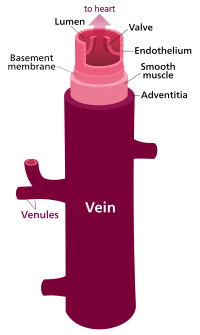
Photo from wikipedia
BACKGROUND Transcatheter aortic valve implantation (TAVI) is increasingly being offered to high-risk patients with symptomatic aortic valve stenosis. Recent reports have suggested a high incidence of subclinical leaflet thrombosis following… Click to show full abstract
BACKGROUND Transcatheter aortic valve implantation (TAVI) is increasingly being offered to high-risk patients with symptomatic aortic valve stenosis. Recent reports have suggested a high incidence of subclinical leaflet thrombosis following bioprosthestic aortic valve replacement. We report the frequency and clinical presentation of leaflet thrombosis identified by cardiac CT in patients referred for follow-up contrast enhanced CT angiography following TAVI. METHODS 91 consecutive patients referred for follow-up contrast-enhanced CT angiography following TAVI were screened for inclusion in this analysis. Out of these, 13 patients were excluded. All CT examinations were performed using a 2nd or a 3rd generation dual-source system (Somatom Definition Flash/Force, Forchheim, Germany). In all patients, retrospectively ECG-gated spiral acquisition with tube modulation was performed to allow for assessment of leaflet motion. All prostheses were analyzed for presence of leaflet thrombosis defined as hypo-attenuated leaflet thickening with or without leaflet restriction. Post-procedural antithrombotic regimen as well as symptom status was documented in all patients. RESULTS 78 consecutive patients (35 males, 81 ± 4 years) were analyzed. TAVI had been performed in all patients (76 transfemoral access, 2 transapical access) with either balloon-expandable prostheses (4 Sapien XT, 64 Sapien 3) or self-expandable prostheses (5 SJM Portico, 5 Symetis Acurate). Follow-up CT angiography was performed at a median of 4 months following index procedure (Interquartile range 1 month). Leaflet thrombosis was detected in 18 patients (23%, 14 Sapien 3, 1 Sapien XT, 2 SJM Portico, 1 Symetis Acurate). In patients with leaflet thickening on CT, only 11% were on either oral anticoagulation or new oral anticoagulants versus 50% for patients with no leaflet thickening (p 0.002). In patients with leaflet thrombosis, 3 leaflets were affected in 5 patients, 2 leaflets in 5 patients and in 8 patient only 1 leaflet was affected. Clinical symptoms (angina, dyspnea or both) were reported in 2/18 patients with leaflet thrombosis (11%) and in both patients a significant increase of the mean echocardiographic gradient over the prosthesis was documented. The peak and mean echocardiographic gradients obtained at the day of CT examination was significantly higher in symptomatic patients versus asymptomatic patients (peak 46 ± 7 vs. 23 ± 11 mmHg, mean 29 ± 7 vs. 12 ± 6 mmHg, p = 0.01 and 0.002, respectively). Follow-up CT was available for 4 patients with complete resolution of the hypo-attenuated leaflet thickening following treatment. CONCLUSION Leaflet thrombosis following TAVI is a relatively frequent finding in patients referred for contrast enhanced CT angiography following TAVI. In the majority of patients it follows a subclinical course and is substantially more frequent in individuals who are not on oral anticoagulation. However, in patients with relevant increase in prosthetic gradients, symptomatic presentations are possible.
Journal Title: Journal of cardiovascular computed tomography
Year Published: 2018
Link to full text (if available)
Share on Social Media: Sign Up to like & get
recommendations!